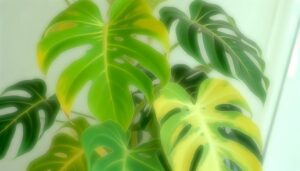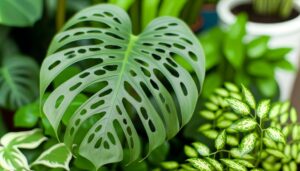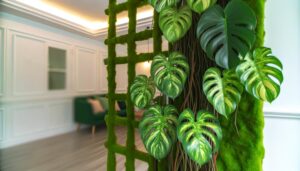Monstera Obliqua Vs Monstera Adansonii
When comparing Monstera obliqua and Monstera adansonii, you'll notice distinct differences in their leaves, growth, and care. Monstera obliqua has thin, delicate leaves with 90% fenestrations, while Monstera adansonii features thicker leaves with 50% smaller holes.
Obliqua grows slowly, producing 1-2 leaves per year, whereas adansonii is fast-growing with multiple new leaves monthly. Obliqua requires higher humidity levels (80-90%) compared to adansonii's 60-70%.
Obliqua is rare and pricey ($1,000-$3,000), contrasted with adansonii's common availability and lower cost ($20-$100). Understanding these differences will help you select the right one for your collection and further your knowledge.
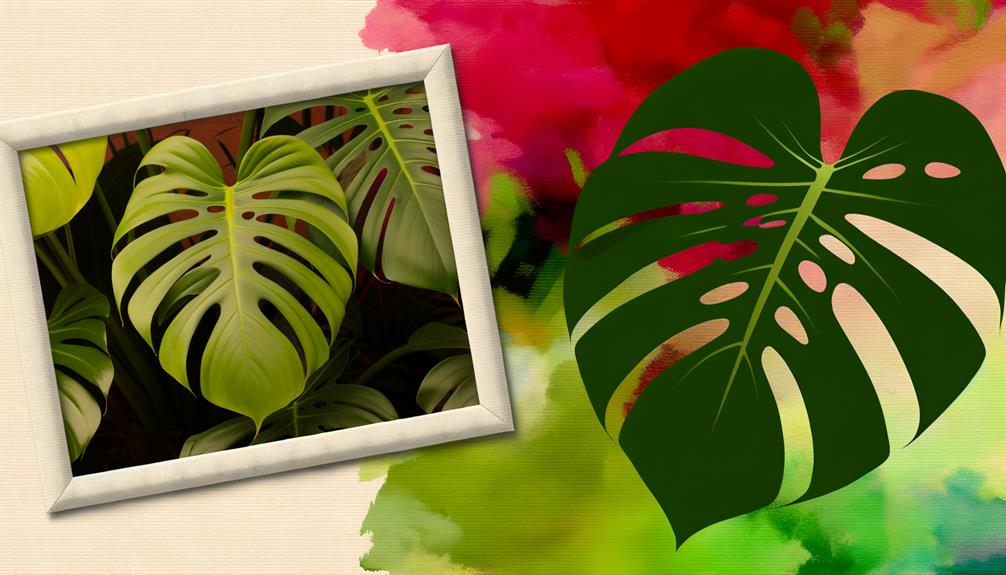
Key Takeaways
- Monstera obliqua has thin, lace-like leaves with large fenestrations, while Monstera adansonii has thicker leaves with smaller holes.
- Monstera obliqua grows slowly, producing 1-2 new leaves per year, whereas Monstera adansonii grows vigorously with multiple new leaves monthly.
- Monstera obliqua requires higher humidity levels (80-90%) compared to Monstera adansonii (60-70%).
- Monstera obliqua is extremely rare and expensive, costing between $1,000 to $3,000, while Monstera adansonii is more common, priced from $20 to $100.
- Both species need a well-draining soil mix of peat moss, perlite, and orchid bark to thrive.
Origins
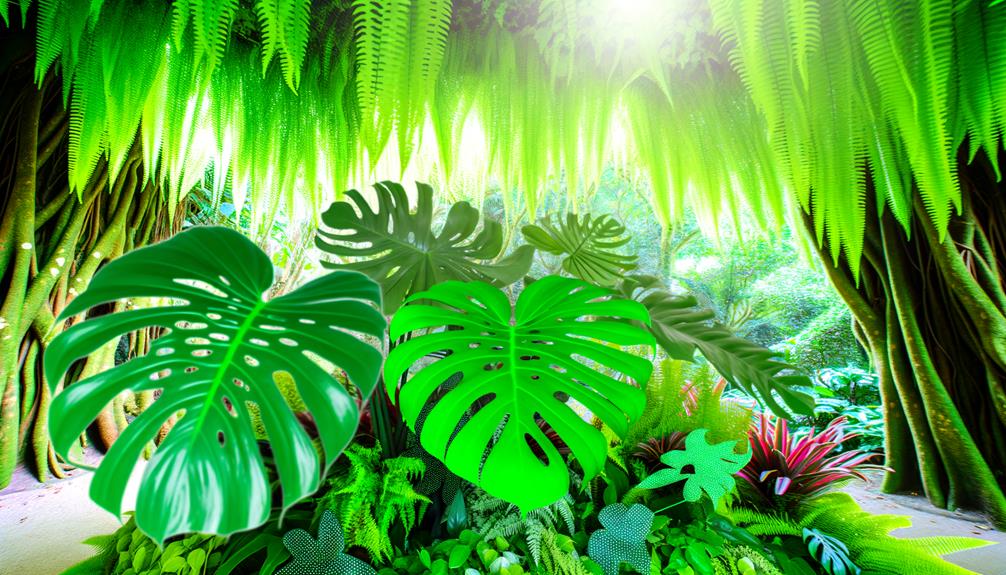
Both Monstera obliqua and Monstera adansonii originate from the tropical rainforests of Central and South America, thriving in humid, low-light environments. You'll find these species in regions with consistent temperatures ranging from 20°C to 30°C (68°F to 86°F) and relative humidity levels of 70% to 90%.
In their natural habitat, they grow as epiphytes, attaching themselves to trees and absorbing nutrients from the surrounding air and rain. These conditions allow them to develop their characteristic aerial roots, which aid in stability and nutrient uptake.
Understanding their origins helps you replicate their natural environment at home, ensuring ideal growth. Maintaining similar humidity and temperature levels indoors will make these plants flourish, mirroring their native rainforest conditions.
Appearance
When comparing Monstera obliqua and Monstera adansonii, you'll notice that Monstera obliqua has much thinner leaves with larger fenestrations, whereas Monstera adansonii features thicker, more robust leaves with smaller, more evenly spaced holes. The leaf texture of Monstera obliqua is delicate, almost papery, and the fenestrations can occupy up to 90% of the leaf surface. In contrast, Monstera adansonii exhibits a leathery texture with fenestrations that typically cover about 50% of the leaf area.
Here's a quick comparison:
| Feature | Monstera obliqua | Monstera adansonii |
|---|---|---|
| Leaf Thickness | Very thin | Thick and robust |
| Fenestration Size | Larger, irregular openings | Smaller, evenly spaced holes |
| Leaf Texture | Delicate, almost papery | Leathery, sturdy |
These differences make each species uniquely alluring.
Leaf Structure
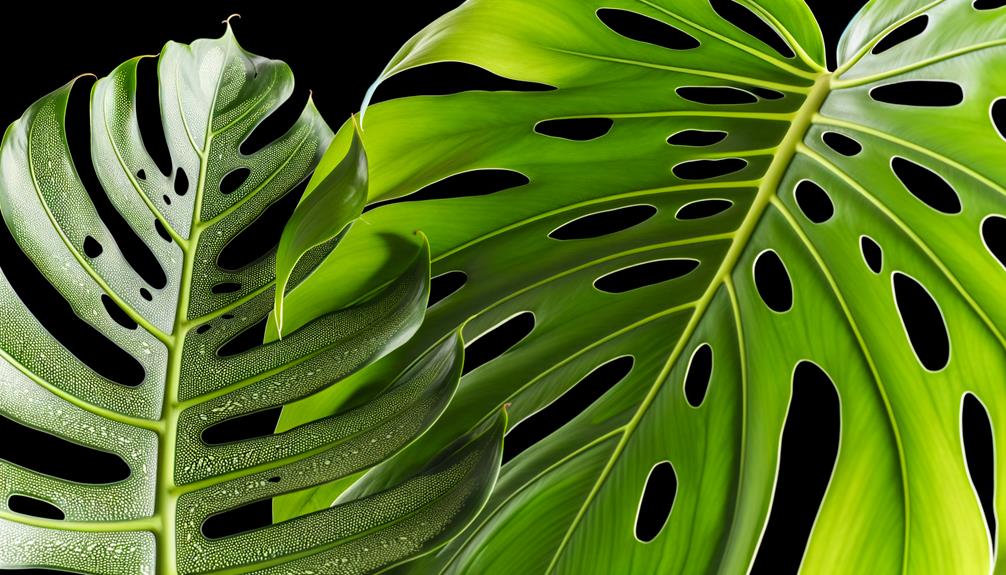
Monstera obliqua's leaf structure features exceptionally thin, almost translucent tissue with fenestrations that can span up to 90% of the surface area, creating a highly perforated appearance. These fenestrations, or holes, are irregularly shaped and vary in size, giving the leaves a distinctive, lace-like look. The leaf blade itself is incredibly delicate, measuring around 0.2-0.5 mm in thickness.
In contrast, Monstera adansonii exhibits thicker leaves, typically measuring 1-2 mm in thickness. The fenestrations are more uniform and occupy less surface area, usually around 50-60%. Adansonii's leaves are more robust and less prone to tearing.
These structural differences make each species unique and influence their care requirements. Understanding these distinctions helps you better appreciate and nurture these fascinating plants.
Growth Rate
When it comes to growth rate, you'll notice that Monstera obliqua grows much slower than Monstera adansonii, often producing new leaves at a rate of just one or two per year under ideal conditions.
Monstera adansonii, on the other hand, exhibits a more vigorous growth pattern, generating new leaves more frequently.
To better visualize their growth:
- Monstera obliqua:
- New leaves: 1-2 per year
- Leaf emergence: gradual
- Stem elongation: minimal
- Root development: slow
- Monstera adansonii:
- New leaves: multiple per month
- Leaf emergence: rapid
- Stem elongation: noticeable
- Root development: moderate to fast
This stark contrast highlights Monstera obliqua's more delicate and less aggressive growth, making it a rare and prized specimen among enthusiasts.
Care Requirements

When caring for Monstera Obliqua and Monstera Adansonii, you need to think about light intensity, precise watering schedules, and best humidity levels.
Place them in bright, indirect light with a preference for 200-400 foot-candles.
Maintain humidity at 60-80% and water when the top 1-2 inches of soil are dry for healthy growth.
Light and Placement
Both Monstera obliqua and Monstera adansonii thrive in bright, indirect light, ideally receiving around 200 to 400 foot-candles for best growth. To achieve this ideal lighting, you should place your plant in a location that mimics its natural habitat.
- Near an East-facing window: This provides soft morning light without the harsh midday sun.
- Filtered light through sheer curtains: This diffuses intense rays, preventing leaf scorch.
- Under a sheer canopy outdoors: Simulating dappled sunlight found in tropical forests.
- Positioned a few feet from a South-facing window: Ensuring bright, indirect light while avoiding direct exposure.
Watering Needs
Properly watering Monstera obliqua and Monstera adansonii involves maintaining consistently moist soil without allowing it to become waterlogged or dry out completely. To achieve this, you should water thoroughly when the top 1-2 inches (2.5-5 cm) of soil feel dry to the touch.
Use room-temperature, dechlorinated water to prevent shocking the roots. Make sure the pot has drainage holes to eliminate excess water, thereby preventing root rot. For precise hydration, consider using a soil moisture meter, aiming for a reading of 4-6 on the scale.
During the growing season, typically spring and summer, these plants may require more frequent watering, while in the dormant winter months, you should reduce the frequency to avoid overwatering.
Humidity Preferences
Monstera obliqua and Monstera adansonii thrive in environments with humidity levels between 60% and 80%, mimicking their native tropical habitats. To achieve this, you should consider the following:
- Humidifiers: Use a high-quality humidifier to maintain consistent humidity levels, especially during dry seasons.
- Misting: Regularly mist the leaves with distilled water to replicate the natural moisture they receive in the wild.
- Pebble Trays: Place a tray filled with water and pebbles under the plant pot to increase ambient humidity through evaporation.
- Grouping: Cluster your plants together; the collective transpiration will naturally elevate the humidity around them.
Light Needs
Understanding the light needs of Monstera obliqua and Monstera adansonii is crucial for their finest growth and health. Monstera obliqua thrives in bright, indirect light, mimicking the dappled sunlight of its native tropical forests. Guarantee it receives 10,000 to 20,000 lux for optimal photosynthesis without leaf scorching.
Conversely, Monstera adansonii tolerates lower light levels, around 5,000 to 15,000 lux, but still prefers bright, indirect sunlight. Avoid direct sunlight, as it can cause leaf burn in both species. Positioning your plants near east or north-facing windows can provide suitable illumination.
Use a light meter to measure lux levels accurately, ensuring your Monstera gets the precise intensity needed for lush, healthy foliage. Proper light management promotes vigorous growth and vibrant leaves.
Watering
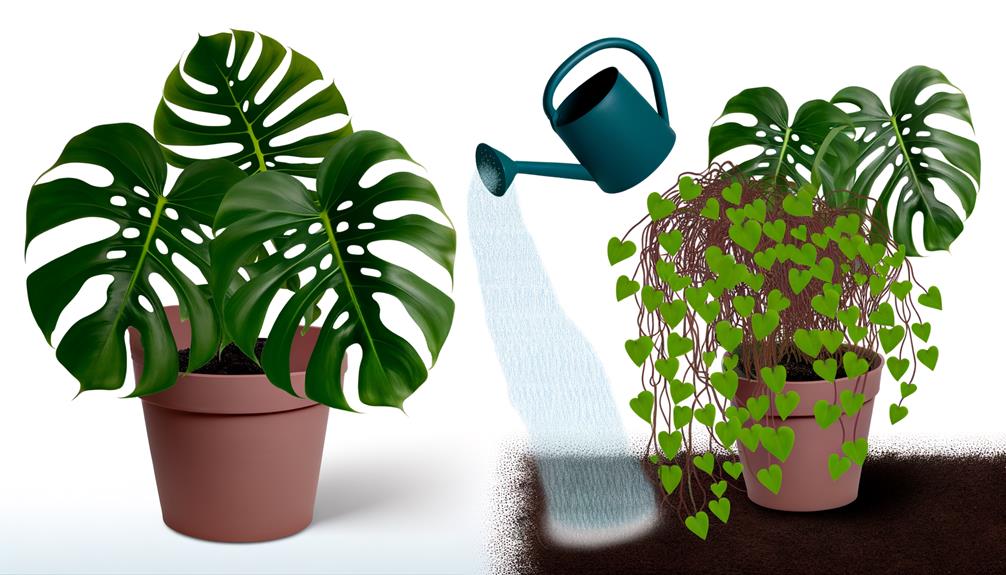
Securing consistent soil moisture is pivotal for the health of both Monstera obliqua and Monstera adansonii. The former needs slightly more regular watering due to its delicate foliage. You'll want to maintain the soil evenly moist but not waterlogged.
Here's how you can do it effectively:
- Check Soil Moisture: Put your finger 1-2 inches into the soil. If it feels dry, it's time to water.
- Water Quantity: Use a measured amount of water, around 1 cup for smaller pots and 2 cups for larger pots.
- Drainage: Ensure pots have drainage holes to avoid root rot.
- Humidity: Sustain ambient humidity levels around 60-70% using a humidifier or pebble tray.
Soil Preferences
When considering soil preferences for Monstera Obliqua and Monstera Adansonii, you'll need to focus on their best soil composition and specific moisture retention needs. Monstera Obliqua thrives in a well-aerated mix with high organic content, ensuring sufficient drainage, while Monstera Adansonii prefers a slightly more moisture-retentive medium.
Both species benefit from a pH range of 5.5 to 7, promoting best nutrient absorption.
Ideal Soil Composition
Both Monstera obliqua and Monstera adansonii thrive in a well-draining soil mix composed of one part peat moss, one part perlite, and one part orchid bark, ensuring ideal moisture retention and aeration. To create this perfect blend, follow these specific steps:
- Peat moss: Provides moisture retention and a slightly acidic pH.
- Perlite: Enhances drainage and prevents soil compaction.
- Orchid bark: Increases aeration and mimics natural tropical environments.
- Mix ratio: Combine equal parts (1:1:1) for best results.
This mix creates an environment that supports root health and nutrient uptake. Always guarantee the soil is loose and well-aerated to prevent root rot and promote vigorous growth. This combination is scientifically proven to meet the unique needs of these Monstera species.
Moisture Retention Needs
For best growth, Monstera obliqua and Monstera adansonii require soil that maintains consistent moisture levels without becoming waterlogged. You should use a well-draining mix containing 40% peat moss, 30% perlite, and 30% orchid bark. This composition ensures ideal aeration while retaining sufficient moisture. Avoid heavy soils that retain too much water, as they can lead to root rot.
Monitor the soil moisture using a hygrometer to maintain levels between 40-60% moisture content. Water when the top 2-3 inches of soil feel dry to the touch. Consistent watering at this stage prevents stress and promotes healthy root development.
Adding a layer of mulch can help retain moisture and regulate soil temperature, advantageous for both Monstera species.
Humidity Needs
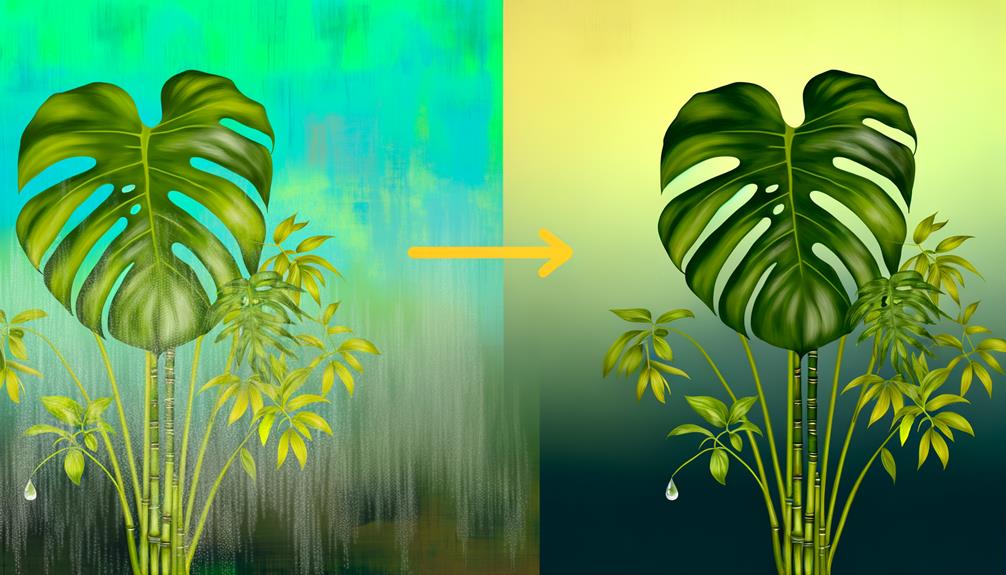
Although both Monstera obliqua and Monstera adansonii thrive in environments with high humidity, Monstera obliqua requires a more consistent humidity level of around 80-90% to maintain ideal health.
To achieve optimum conditions for Monstera obliqua, you should:
- Utilize a hygrometer: This device measures humidity levels accurately, ensuring they stay within the required range.
- Mist regularly: Use a fine mist to increase ambient humidity around the plant.
- Position near a humidifier: A humidifier can help maintain consistent moisture levels in the air.
- Group plants together: This can create a microenvironment with higher humidity due to transpiration.
In contrast, Monstera adansonii adapts well to slightly lower humidity levels, around 60-70%.
Availability
When considering availability, you'll notice Monstera obliqua's extreme rarity in the market due to its slow growth rate and limited propagation.
In contrast, Monstera adansonii is more commonly found in nurseries, maintaining higher stock levels.
Consequently, Monstera obliqua commands notably higher prices and higher demand among collectors.
Rarity in Market
Due to its extreme scarcity in the wild and slow growth rate, Monstera obliqua is much rarer in the market compared to Monstera adansonii.
You'll find that Monstera obliqua's limited availability stems from several factors:
- Natural Habitat: Monstera obliqua is found in very specific, remote tropical regions.
- Growth Rate: It grows at a notably slower pace, requiring precise conditions.
- Propagation: Successful propagation is challenging due to its delicate structure.
- Demand: High demand among collectors further exacerbates its rarity.
Monstera adansonii, in contrast, is more readily available.
Its robust growth rate, adaptability, and ease of propagation make it a common choice.
If you're seeking a Monstera obliqua, prepare for a more intensive search and higher investment.
Nursery Stock Levels
You'll find Monstera adansonii more frequently stocked in nurseries, reflecting its ease of cultivation and high propagation success rates. With its rapid vegetative growth and minimal environmental requirements, Monstera adansonii is a preferred choice for propagation. Nurseries typically maintain stock levels to meet consumer demand, often propagating new plants via stem cuttings.
In contrast, Monstera obliqua presents a challenge due to its slow growth rate and specific environmental needs, including high humidity (70-90%) and stable temperatures (20-30°C). Consequently, its availability in nurseries is markedly limited. Propagation efforts for Monstera obliqua are less frequent, leading to sporadic nursery stock levels.
Given these factors, you'll encounter Monstera adansonii far more often than Monstera obliqua.
Price and Demand
Given the difference in nursery stock levels, the price and demand for Monstera obliqua and Monstera adansonii also vary significantly. Monstera obliqua, with its rarity and limited availability, commands a considerably higher price. You can expect prices to range from $1,000 to $3,000 per plant.
In contrast, Monstera adansonii is more readily available and affordable, typically costing between $20 and $100.
Here's a clear comparison:
- Monstera obliqua: $1,000 – $3,000
- Monstera adansonii: $20 – $100
- Monstera obliqua: High demand, low supply
- Monstera adansonii: Moderate demand, high supply
Understanding these differences is essential for making an informed purchasing decision based on your budget and the plant's rarity.
Cost
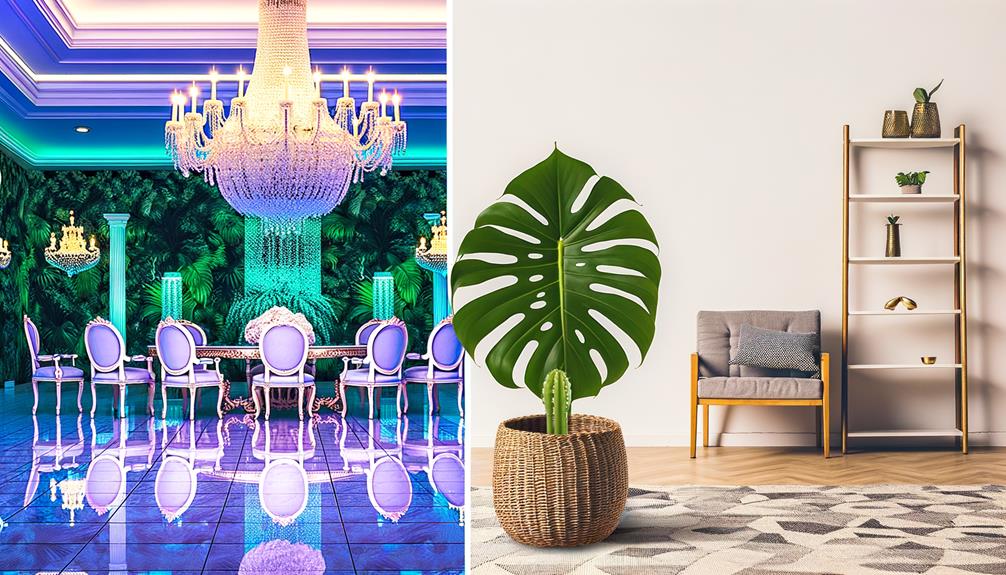
Monstera obliqua typically commands a notably higher price than Monstera adansonii due to its rarity and slower growth rate. The scarcity of Monstera obliqua makes it a coveted specimen among plant enthusiasts, often driving costs up considerably. While Monstera adansonii is more readily available and grows at a faster rate, making it notably more affordable.
Here's a comparison table to illustrate the cost differences:
| Plant Type | Average Cost (USD) | Growth Rate (inches/month) |
|---|---|---|
| Monstera Obliqua | $500 – $5,000 | 0.5 – 1 |
| Monstera Adansonii | $20 – $100 | 2 – 4 |
Understanding these factors helps you make an informed decision based on budget and growth expectations.
Conclusion
In comparing Monstera obliqua and Monstera adansonii, you've discovered their unique origins, distinct appearances, and varying leaf structures.
You've noted their differing growth rates, specific care requirements, and particular soil preferences.
You've understood their humidity needs, assessed their availability, and evaluated their costs.
By appreciating these detailed distinctions, you're better equipped to choose the perfect Monstera for your collection, ensuring it thrives under your meticulous care.
Embrace this knowledge and watch your chosen Monstera flourish.

